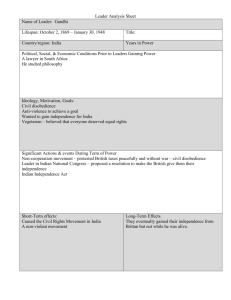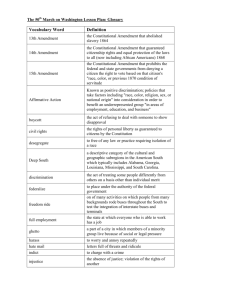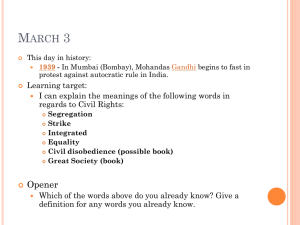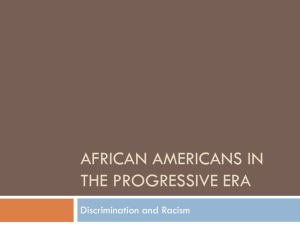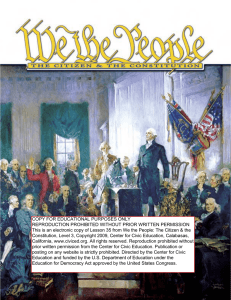Civil Rights Act of 1964
advertisement
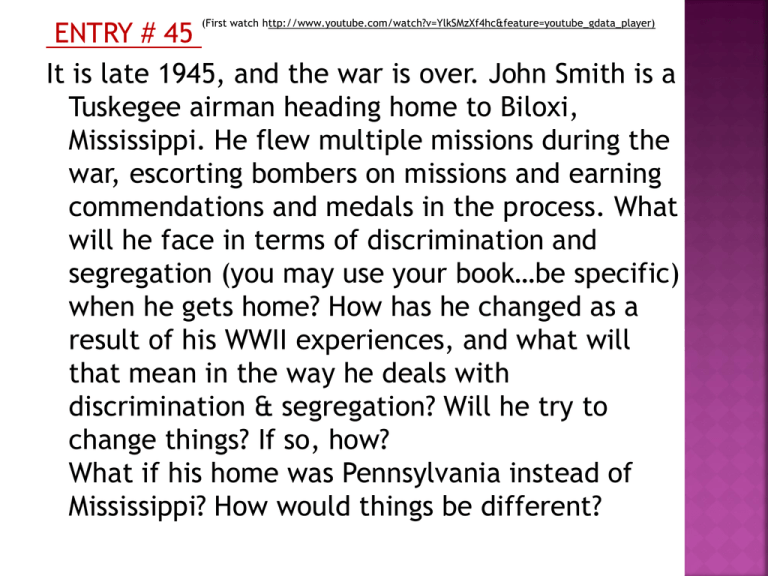
ENTRY # 45 It is late 1945, and the war is over. John Smith is a Tuskegee airman heading home to Biloxi, Mississippi. He flew multiple missions during the war, escorting bombers on missions and earning commendations and medals in the process. What will he face in terms of discrimination and segregation (you may use your book…be specific) when he gets home? How has he changed as a result of his WWII experiences, and what will that mean in the way he deals with discrimination & segregation? Will he try to change things? If so, how? What if his home was Pennsylvania instead of Mississippi? How would things be different? (First watch http://www.youtube.com/watch?v=YlkSMzXf4hc&feature=youtube_gdata_player) Gains in the 40s Brown vs. Board of Education The Rise of the SCLC and Nonviolent Civil Disobedience Segregation and Civil Rights quickly became important national topics after WWII. Truman had desegregated the armed forces in 1948 by Executive Order 9981…why here first? Would have liked to have done more but there was massive resistance to integration at the time. However, racial segregation in America seemed hypocritical after a war against extreme racism (Nazis) and during a cold war of our “freedom and democracy” against Soviet communism Robinson broke the baseball color barrier when the Brooklyn Dodgers started him at first base on April 15, 1947. As the first major league team to play a black man since the 1880s, the Dodgers ended racial segregation that had relegated black players to the “Negro Leagues” for six decades. The example of Robinson's character and unquestionable talent challenged the traditional basis of segregation, which, at the time, marked many other aspects of American life, and contributed significantly to Civil Rights Mvmt. By 1950s the National Association For the Advancement of Colored People (NAACP) was the largest civil rights organization in the US. They decided to challenge Segregation and Plessy v. Ferguson through the court system. Their first target: public education A team of NAACP lawyers, led by Thurgood Marshall (later the first African American Supreme Court Justice) argued that Plessy v. Fergson’s “Separate but Equal” was not actually equal at all, especially in the area of public education, and that segregation went agains the 14th Amendment of equal protection under the law” Court ruled that all schools must be desegregated “with all deliberate speed.”, overturning Plessy. 100 southern members of Congress (including Samuel and W. Kerr Scott of D-North Carolina) and signed an agreement (Southern Manifesto), opposing the integration of schools. Some states temporarily closed public schools, rather than integrate. Little Rock Central High School, Little Rock, AK. 9 black students registered to attend the white school As ordered by the Arkansas Governor the Arkansas National Guard blocked the students from entering the school way. Having taken the Presidential Oath “to protect and defend the Constitution,” Eisenhower sent federal troops to protect the black students as they walked to school in 1956 READ THIS: Civil disobedience is defined by Wikipedia as “the active, professed refusal to obey certain laws, demands, and commands of a government, or of an occupying international power. Civil disobedience is commonly, though not always, defined as being nonviolent resistance. There have been debates as to whether civil disobedience must necessarily be non-violent. Black's Law Dictionary includes nonviolence in its definition of civil disobedience. Christian Bay's encyclopedia article states that civil disobedience requires "carefully chosen and legitimate means," but holds that they do not have to be nonviolent. It has been argued that, while both civil disobedience and civil rebellion are justified by appeal to constitutional defects, rebellion is much more destructive; therefore, the defects justifying rebellion must be much more serious than those justifying disobedience, and if one cannot justify civil rebellion, then one cannot justify a civil disobedients' use of force and violence and refusal to submit to arrest. Civil disobedients' refraining from violence is also said to help preserve society's tolerance of civil disobedience. But McCloskey argues that ‘if violent, intimidatory, coercive disobedience is more effective, it is, other things being equal, more justified than less effective, nonviolent disobedience.’" THEN:ENTRY # 46:Read the documents(A-D) on page 817 of your textbook and answer the questions (1-4) at the bottom of the page. Rosa Parks ("the first lady of civil rights“) was asked to move from her bus seat on December 1, 1955, in Montgomery, Alabama. When Parks refused to obey the bus driver’s order to give up her seat in the colored section to a white passenger, after the white section was filled, she was arrested. An active member of the NAACP, Parks’ arrest touched off the Montgomery Bus Boycott, which lasted from 12/1/55 to 12/20/56, and which resulted in a federal civil rights victory and the legal desegregation of public buses. In a 1992 interview with National Public Radio's Lynn Neary, Parks recalled: I did not want to be mistreated, I did not want to be deprived of a seat that I had paid for. It was just time... there was opportunity for me to take a stand to express the way I felt about being treated in that manner. I had not planned to get arrested. I had plenty to do without having to end up in jail. But when I had to face that decision, I didn't hesitate to do so because I felt that we had endured that too long. The more we gave in, the more we complied with that kind of treatment, the more oppressive it became. Baptist minister and black community leader in Montgomery, Alabama Led the Bus Boycott, making a national name for himself as a result of the boycott and became the nationally recognized leader of the Civil Rights Movement, who remained committed to the non-violent protest. April,1963 “Letter From a Birmingham Jail”- will Kennedy to support a tougher civil rights bill before his death in late http://www.youtube.com/watch ?v=nFcbpGK9_aw 1963 August, 1963 - March on Washington in support of this civil rights bill. “I Have a Dream” speech. MLK helped establish (in 1957) this group of ministers who worked to nonviolently end segregation. Included Ralph Abernathy, who organized the March on Washington Early 1960s Civil Rights Act 1964 Later Militancy Among young African Americans, there was a swell of popular support for civil rights, partly rising out of frustration for the slow movement of change Sit-ins (wade-ins, read-ins) all over the south SNCC (Student Nonviolent Coordinating Committee) formed in Spring, 1960 at Shaw University. In 1964, the SNCC Freedom Summer project to register African American voters in Mississippi resulted in the murder of 3 civil rights workers February 1, 1960 Woolworth’s Counter Sit-in in Greensboro, NC Meant to force the Federal Government to enforce their decision to desegregate interstate commerce. Two buses full of people traveled around the south defying segregation laws. One bus was firebombed; the other attacked by a white mob in Birmingham, Alabama JFK vocally supported civil rights, especially in his later 1963 speeches (after Birmingham, Al. & MLK arrest). His brother, Robert, pushed for civil rights legislation in his position as Attorney General and when he ran for President in 1968. Johnson used Kennedy’s death to push the Civil Rights Act of 1964 through Congress. Outlawed segregation in public places and discrimination in employment on the basis of race, sex, color or national origin. –-- prosecute-able by Federal Justice Department Massive Televised violence against non-violent protesters shocked the nation on March 7,1965. President Johnson made a televised speech calling for strong federal (rather than states) voting rights laws. Voting Rights Act of 1965 Outlawed literacy tests and allowed the federal government to oversee voter registration 24th Amendment (ratified 1964) No poll taxes for voting 1965-67 –huge riots rocked large American cities. Los Angeles, Detroit, Newark,, etc. How different did daily life actually look for most Black Americans? Violence beginning to replace non-violence in the civil rights movement… Malcolm X (Born Malcolm Little) in 1925 in Omaha, Nebraska) had a difficult early life, including drugs and crime, but turned away from all that after converting to Islam. Would become an important, though controversial civil rights leader, criticizing King’s nonviolence and advocating black violence in self-defense to counter white violence: “We declare our right on this earth to be a man, to be a human being, to be respected as a human being, to be given the rights of a human being in this society, on this earth, in this day, which we intend to bring into existence by any means necessary.” - Malcolm X, 1965 Political party Would arrange armed patrols of black neighborhoods. Led to violent confrontations with the police in many cities. Became the vocal advocate of “Black Power” (Stokely Carmichael’s term) Stokely Carmichael rather than integration. Huey P. Newton Bobby Seale
